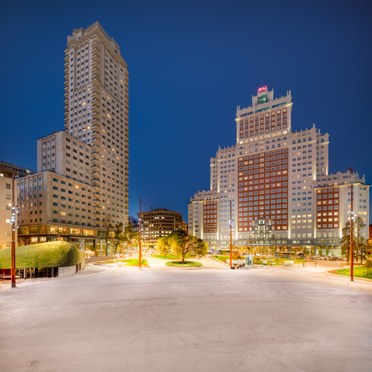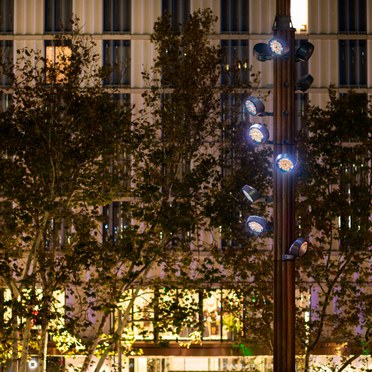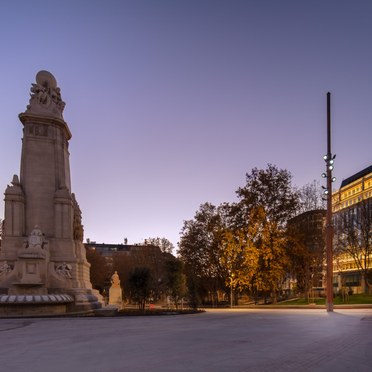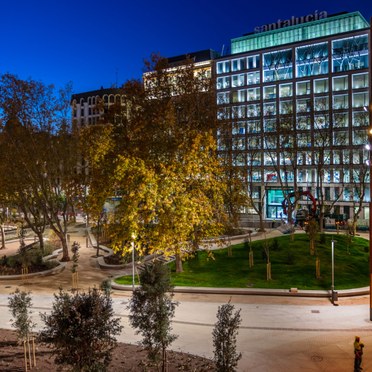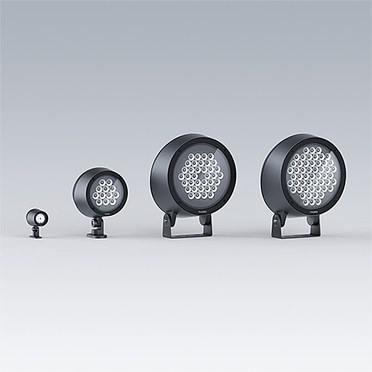Plaza De España, Madrid
Products
- Lamp efficacy
Lamp efficacy
Ensuring the lamp efficiently converts electricity into light (lm/W).
- Ballast classification
Ballast classification
Controlling the electricity supply to the lamp (Energy Efficiency Index).
- Luminaire distribution
Luminaire distribution
Controlling light emission using optics which bend and shape the light to the correct location.
- System efficacy
System efficacy
Combining optical and thermal control within the luminaire (luminaire lm/W).
- Presence/absence detection
Presence/absence detection
Presence: Lights automatically turn on/off with movement. Absence: Lights automatically turn off and must be manually switched on.
- Daylight detection
Daylight detection
Artificial lighting which responds to the natural light conditions.
- Constant illuminance
Constant illuminance
A function designed to produce correct light levels for the duration of the maintenance period.
- Task-scene setting
Task-scene setting
Allowing the user to set scenes and adapt the lighting to different tasks.
- Timed off
Timed off
Automatic cut-off can be installed to turn all lights off during unoccupied hours.
- Task lighting
Task lighting
Lighting task areas with the correct amount of light.
- Zoning of lighting
Zoning of lighting
Lighting is zoned according to area use.
- Maintenance schedule
Maintenance schedule
Maintenance must be performed in response to product age, performance and environment.
- Waste light
Waste light
Eliminating waste light which does not hit the intended target.
- Reflectance
Reflectance
Taking advantage of light which is reflected from the surface within the space.
- Visible smart metering
Visible smart metering
Results of actions can be quickly seen as increased or decreased energy use to encourage responsible energy consumption.
Thorn has recently worked with Madrid City Council on the most anticipated and important urban project of recent years: the rebirth of Plaza de España. This unprecedented landscape reconfiguration and large-scale project links the Royal Palace, Plaza de Oriente, Jardines de Sabatini, Madrid Río and the Temple of Debod to the Gran Vía.
Welcome Mother Nature is the name of the proposal that was lead by architects Lorenzo Fernández-Ordóñez, Aránzazu La Casta, and Fernando Porras-Isla. The project proposed four major elements in one: to profoundly transform car mobility, to create large accessible areas dedicated to pedestrians and cyclists, to incorporate a large stand of trees connecting the adjacent parks, and to enhance and reveal the remains of the valuable historical heritage of this enclave, origin of the city.
This immense green environment features more than a thousand trees in a landscape reconfiguration that goes beyond the functional and where light plays a fundamental role. To bring this magnificent proposal to life, Thorn Lighting actively participated in the project through two different but coordinated work strategies: the lighting of the large circular esplanade and its entrance points.
At the entrances, a warm light guides and invites you to stroll into the pedestrian area that's 75 meters in diameter, a meeting point for citizens and visitors. The light beams are oriented and adjusted to the limits of the architecture, establishing an interesting and beautiful contrast between the entrance paths and green areas.
As the visitor enters this large pedestrian area, light bathes the space, creating ambience and identity. Prepared for all kinds of events, the square has a dynamic and flexible lighting system that was developed by Thorn in collaboration with the architects. The technological proposal will allow the creation of different atmospheres and lighting scenes depending on the time of year, type of event or special dates in the calendar, such as the Christmas scene, which alternates playful transitions of green and red.
This double lighting maneuver has been possible thanks to Contrast luminaires whose versatility and elegant design add value and quality to the architectural environment. Distributed along 7 columns of 22 meters high and a triangular geometry - designed by the architects, authors of the project, and executed by Setga - the luminaires join the natural wood finish with ball joints specifically designed for the project.
In order to unify aesthetic criteria, the same Contrast model is used in two versions of light emission. For the pedestrian access points, a 3000K color temperature was chosen with the possibility of intensity regulation, while in the main square the RGBW version is used, offering different light scenes, colors and shapes. Its great flexibility allows the different surface finishes of Galician granite flooring to be illuminated in a uniform way.
A unique city project accompanied by special lighting that combines design and lighting criteria. A proposal for urban lighting that fosters greater awareness of the importance of light in public space and with which Madrid experiences the rebirth of a green, open and flexible area capable of transforming the city through an architecture that shines and reveals itself to be beautiful, thanks to the magic of light.
Architecture and landscaping, pole design and lighting idea:Lorenzo Fernández Ordóñez, Aránzazu La Casta and Fernando Porras-Isla.
Promoter and owner:Madrid City Council
Constructor:UTE Pacsa FCC
General Engineering:Prointec
Structural Engineering:Grahen
Pole development Engineering: Setga, with the collaboration of the University of Vigo and the University of Valladolid.
Installer:Urbalux
Photography of Thorn Contrast luminaires in Plaza de España:Luzestudio Fotografía

